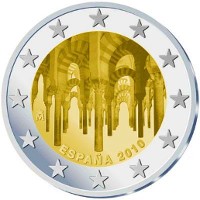 The new commemorative 2 Euro coin of Spain, Historic Centre of Cordoba, belongs to the UNESCO World Heritage series.
The coin shows the inside of the Mosque of Cordoba, representative of Muslim architecture.
Cordoba's period of greatest glory began in the 8th century after the Moorish conquest, when some 300 mosques and innumerable palaces and public buildings were built to rival the splendours of Constantinople, Damascus and Baghdad. In the 13th century, under Ferdinand III, the Saint, Cordoba's Great Mosque was turned into a cathedral and new defensive structures, particularly the Alcazar de los Reyes Cristianos and the Torre Fortaleza de la Calahorra, were erected.
Cordoba (often Cordova in English) is a city in Andalusia, southern Spain, and the capital of the province of Cordoba.
Located on the Guadalquivir river, it was founded in ancient Roman times as Corduba by Claudius Marcellus.
Today a moderately-sized modern city, the old town contains many impressive architectural reminders of when Cordoba was the thriving capital of the Caliphate of Cordoba that governed almost all of the Iberian peninsula. It has been estimated that Cordoba, with up to 500,000 inhabitants in the tenth century, was the largest city in Western Europe and, perhaps, in the world.
Cordoba was the capital of the Roman province of Hispania Ulterior Baetica. Great Roman philosophers like Lucius Annaeus Seneca the Younger, orators like Seneca the Elder and poets like Lucan came from Roman Cordoba. Later, it occupied an important place in the Provincia Hispaniae of the Byzantine Empire (552-572) and during the Visigoth period.
It was captured in 711 by the Muslims, and Cordoba became capital during the Umayyad Caliphate, the period of its apogee, with a population supposedly ranging between 250,000 and 500,000 inhabitants. However, most scholars feel that these numbers are historically inflated.
In the 10th century, Cordoba was one of the most advanced cities in the world, as well as a great cultural, political and economic centre. The Cordoba Mosque dates back to this time.
In 1236 it was captured by King Ferdinand III during the Spanish Reconquista.
With one of the most extensive historical heritages in the world it was declared a World Heritage Site by UNESCO, December 17th, 1984.
The city also features a number of modern areas, including the districts of Zoco and the railway station district.
|